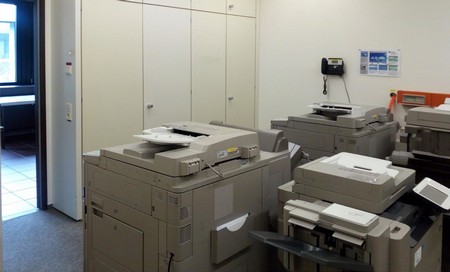Abschnitt 3.6 - 3.6 Equipment areas
In equipment areas, your employees come into direct contact with printers, photocopiers, fax machines, shredders, scanners and servers. These devices may present a range of hazards. This chapter describes the hazards and the measures to be taken for their avoidance.

 | Statutory references |
|---|---|
| |
 | Further information |
|---|---|
| |
 | Hazards |
|---|
Office equipment may present the following hazards to your employees:
Electric shock caused for example by defective power cables or casings
Falls and tripping caused for example by poor routing of cables
Pinching and collision on furniture and equipment
Tipping and falling of furniture and equipment
Fire hazards caused by smouldering cables
Noise caused by equipment
Emissions from printers and photocopiers
Rise in atmospheric temperature caused by office equipment
 | Measures |
|---|
Ensure that all electrical equipment is tested at the specified intervals by a skilled electrician or under the instruction and supervision of a skilled electrician. Instruct your employees to check the power leads and casings of the equipment visually at regular intervals for evident damage.
Pay attention to proper arrangements for power cables (for example, do not daisy-chain multiple trailing sockets).
Avoid tripping hazards (for example by using cable ramps).
Keep circulation routes free of collision and tripping hazards. Provide circulation routes of adequate width (see Chapter 3.3.1) and ensure that materials (such as cardboard boxes) and work equipment are not left on circulation routes or encroaching into them.
Remove legacy equipment and cables after they have been taken out of service, and dispose of them properly.
Ensure free movement areas and functional areas of adequate dimensions (see Chapter 3.3.1) in order to ensure that the equipment can be operated safely and ergonomically.
Provide storage space and work surfaces adjacent to photocopiers and printers.
Ensure that office equipment and furniture are stable.
Avoid placing office equipment on the edges of furniture such that the equipment projects over the edge of the furniture.
Make suitable fire extinguishing equipment available and provide your employees with practical instruction in its use.
 Note that the use of CO2 fire extinguishers in constrained spaces may present a risk of suffocation for the
employees.
Note that the use of CO2 fire extinguishers in constrained spaces may present a risk of suffocation for the
employees.
Water and foam fire extinguishers to EN 3, Portable fire extinguishers, may be used on electrical equipment up to 1,000 V provided a safe distance of at least 1 m is observed.
Procure low-noise office equipment products.
Where possible, place this equipment in a dedicated equipment room in order to prevent intrusive noise and a rise in the atmospheric temperature in the areas in which your employees work.
| Emissions from printers and photocopiers Emissions from printers and photocopiers are frequently the subject of much discussion in the media. Printers and photocopiers may emit small quantities of dust, volatile organic compounds (VOCs) and ozone. Owing to technical progress, many modern office equipment products now generate virtually no measurable ozone. The dust emissions may be both paper and house dust, and minute quantities of toner dust. The paper dust is by far the largest component of the dust. Various studies have shown the emissions from regularly maintained items of equipment to be in the uncritical range. |
|---|
